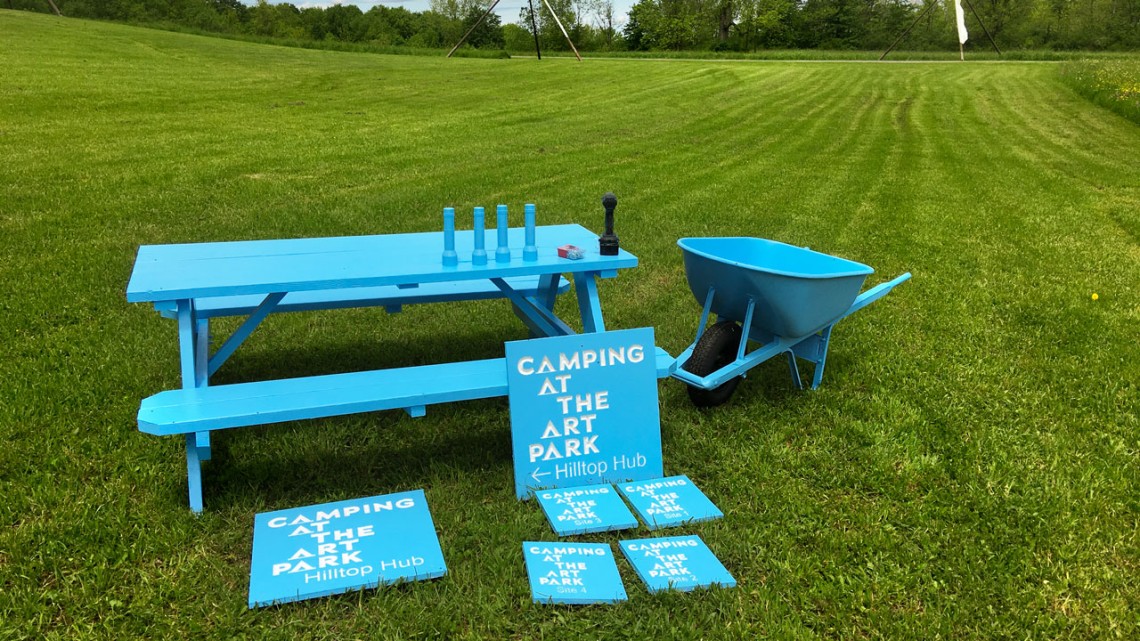
Created by Martin Hogue, Camping at the Art Park at Stone Quarry Hill Art Park in Cazenovia, New York, includes picnic tables, signage, chairs, a wheelbarrow, and even flashlights, all painted the same bright shade of blue.
Tracing camping’s evolution, from Adirondacks to art park
By James Dean, Cornell Chronicle
Pulling into a Kampgrounds of America near the Badlands of South Dakota more than 20 years ago, Martin Hogue was surprised to receive a map showing numbered tent and RV sites in addition to a swimming pool, miniature golf course and dog park – even named streets, as if he’d entered a small village.
“This was my first camping experience, so I really had no other bearings than what I’d seen in films or read in books,” said Hogue, associate professor of landscape architecture in the College of Agriculture and Life Sciences. “I fancied myself a rugged adventurer going into nature. Instead, a destination was prescribed for me by the campground’s attendant, who carefully circled the location of my campsite on a printed map. I was admittedly a little surprised, but also intrigued. I thought, were all campgrounds like this?”
It’s a question Hogue has explored in a series of research projects and as a designer, most recently as an artist-in-residence at Stone Quarry Hill Art Park in upstate New York, where he created its four-week Camping at the Art Park summer program.
Hogue proposed the program after publishing “Thirtyfour Campgrounds,” a photographic survey of nearly 6,500 American campsites – each, he suggests, a stage upon which campers perform a series of ritualized activities, often alongside comforts brought from home. His next book, “Making Camp: A Visual History of Camping’s Most Essential Items and Activities,” scheduled to publish next year, will examine in eight essays the history and design of campgrounds’ major components – from tents and sleeping bags to picnic tables, fire pits and orientation maps. In the process he traces the roughly 150-year arc of recreational camping’s origins from an exclusive experience in the Adirondacks – not so unlike modern “glamping,” Hogue said – to what it is today, with tens of millions of Americans camping each summer.
The rise of car camping in the 1920s led to campgrounds’ increasing standardization by the 1930s, a process Hogue said was heavily influenced by New Deal planners including Emilio Pepe Meinecke, a plant pathologist and National Park Service consultant who was concerned about cars’ destructive impacts. One-way loop roads with pull-ins for vehicles and fixed locations for tents, fire pits and heavy picnic tables became the norm.
In “An Illustrated History of the Picnic Table,” Hogue explains how camping influenced design of the ubiquitous picnic table, whose dimensions were first specified in National Park Service drawings in 1922.
“If you stop and pay attention, you realize that the picnic table is a really unique form,” Hogue said. “It’s not that old, and it’s connected to camping.”
Similarly, he said, campers might be surprised to learn that “sleeping bag” is a relatively new term, entering the lexicon in the mid-19th century.
Hogue sought to celebrate and reinvigorate campgrounds’ signature elements at Stone Quarry Hill Art Park in Cazenovia, which recently hosted campers for the fourth time, over weekends in June.
The project offered visitors a new way to engage with the 104-acre art park’s sculptures and vistas, broadening public outreach in a manner that similar cultural institutions could emulate, Hogue said. At the same time, he said, the campers and campsites themselves became part of the art installation, on display for others to see – until the campground was dismantled, leaving behind only memories of the experience.
In addition to a communal fire pit, Hogue created four numbered and named campsites equipped with a picnic table, Adirondack chairs, a wheelbarrow, a trash can and a flashlight – all painted a striking cyan blue to make them pop from the landscape and, Hogue said, render the spread-out sites legible as a system.
And recalling the experience that sparked his fascination with campsites as architectural spaces, Hogue welcomed guests with an orientation map he designed, featuring a road looping through the art park, icons marking places for camping, parking and eating, and a few key structures and rules.
“It’s been a fascinating journey, because there’s a complexity to it that you would not expect,” Hogue said of his research into camping history and culture. “As an architect and designer by training, being given a map was what triggered all of it.”
Get Cornell news delivered right to your inbox.
Subscribe
